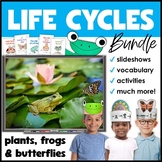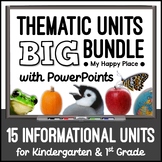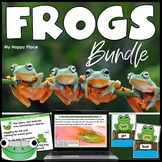Frogs Unit – All About Frogs Slideshow – Life Cycle Activities and More!
- Zip
What educators are saying
Also included in
- This bundle of spring life cycle units is packed with engaging activities sure to spark your students’ curiosity and fill their days with active learning. The three engaging themes (All About Frogs, All About Butterflies, and All About Plants) in this bundle provide primary students with the interesPrice $16.20Original Price $22.50Save $6.30
- Keep your students excited about learning all year long with these informational thematic units for kindergarten and first grade! Each of the 15 units in this set includes a nonfiction PowerPoint slideshow full of eye-catching photos and clear informational text. In addition, with each theme comes aPrice $62.00Original Price $94.75Save $32.75
- This frog bundle is packed full of activities to keep your students interested and engaged this spring. Young students crave information about animals and these frog resources will really hit the spot. The included informational activities will help your students become experts on frogs and the themPrice $11.00Original Price $15.00Save $4.00
Description
This All About Frogs unit is packed full of amphibian learning and fun! Complete with an informational “All About Frogs” PowerPoint, frog crafts, a hat/crown, and lots of printable materials, this set will turn your students into little herpetologists. With eye-catching display materials including headers for three anchor charts along with colorful vocabulary word posters and word wall cards, children will have what they need to read, talk, and write about frogs. This unit teaches students about the frog life cycle, habitat, characteristics, parts of a frog, and more!
This informational frog unit is also included in a few money-saving bundles! Find it in this Frogs Bundle, this Life Cycles Bundle, or this Thematic Units BIG Bundle.
What’s included in this frogs unit?
This “All About Frogs” thematic unit includes materials to help you integrate learning about frogs into science, social studies, literacy, and math in your primary classroom.
Here’s what’s included:
✔ Informational PowerPoint Slideshow “All About Frogs”
This slideshow is packed full of information about frogs. Filled with clear photographs, this presentation includes nonfiction text about frogs’ classification as amphibians, the habitat and diet of frogs, their habits, life cycle, characteristics, and more. This PowerPoint slideshow is 17 slides long and is copied at the end of the PDF in addition to the PPT file (for those without access to PowerPoint).
✔ Frog Vocabulary Word Posters and Word Wall Cards
The included frog vocabulary word posters, each with a photo and a simple definition are: amphibian, camouflage, webbed feet, habitat, predator, cold-blooded, oviparous, and metamorphosis. The word wall cards, each with an illustration, are: eggs, tadpole, frog, froglet, pond, lily pad, amphibian, insects, and water.
✔ Anchor Chart Materials and Posters
Printable materials are included to help you create meaningful frog anchor charts with your students. You’ll find what you need to make a Frogs KWL chart, a “Can, Have, Are” chart, and a “Frog Features” comprehension chart (pocket chart activity). In addition, this set includes a “Parts of a Frog” poster, a “Frog Life Cycle” poster, and an illustrated song and poem to display.
✔ Printable Frog Activities
▶ Themed Informational Writing Materials: In addition to writing organizers, this set includes various frog-themed lined writing sheets, a Can/Have/Are book template, and scaffolded writing templates.
▶ Frog Science Activities: Students cut and glue to complete these life cycle and parts of a frog worksheets. This section also includes a “Frog Actions” worksheet and life cycle-themed writing paper.
▶ Cut and Fold Frog Book: This informational easy reader is designed to be printed double-sided, using only one sheet of paper. Students can color the pictures, then practice reading and print concepts. This book has one simple sentence per page.
▶ Frog Life Cycle Crafts: Choose one of two life cycle crafts (a lily pad or a frog), each with visual instructions for students.
▶ Frog Hat: Use a sentence strip to complete this simple hat that includes two print options. This cute crown is a great culminating activity for your frog unit.
▶ Thematic Printables: This section includes a selection of reading and math skill worksheets with a frog theme. It also includes frog-themed math playing cards and tips for using them in a few different ways.
How do I use this All About Frogs unit?
Begin by accessing students’ background knowledge about frogs by having a class discussion. As you discuss, fill in the “K” (What I Know) and “W” (What I Want to Know) columns of the KWL chart. Follow up with the PowerPoint slideshow, which can be read aloud in one sitting or can be used across several days. Young children will need time to discuss the information as it is presented, so build time for conversations and questions! Upon completion of the PowerPoint (or as you go along), have students help fill in the final column of the KWL chart.
To guide students toward informational writing about frogs, begin with the “Can, Have, Are” chart, having the students help determine what you should write in each section (a sample chart is included). Students can then begin to work on their own organizers which will scaffold them toward writing three informational sentences about frogs. The Can/Have/Are book template, which is included in three levels of difficulty, is a great way for students to showcase their writing skills.
The “Frog Features” chart and the accompanying writing template help students build comprehension. These cards can be used in a pocket chart as whole group comprehension activity. Add sentence cards to the chart while reading the PowerPoint. Have students help select the photo that best supports the sentence. Students can use the follow-up writing page to draw and write about an interesting feature of frogs.
The original frog song (to be sung to the tune of “The Itsy, Bitsy Spider”) and the frog poem help students remember facts about frogs while also working on memorization and rhyme concepts. Consider having students come up with hand motions to go along with the song. Students can sing the song and recite the poem while wearing their hats! A cut-and-glue comprehension sheet accompanies the poem.
The thematic activities can be completed in any order (and you can pick and choose based on the needs and levels of your students).
Have students make frog hats to culminate their studies and encourage them to share frog facts with anyone who asks about their hats!
What Teachers Are Saying about “All About Frogs”:
⭐⭐⭐⭐⭐ “My students enjoyed this resource. The pictures in the slides were very engaging. We liked how they were real pictures instead of clipart. The activities were fun as well.” — Christine B.
⭐⭐⭐⭐⭐ “This PowerPoint is wonderful! My students loved it and learned so much from it. The worksheets are perfect for my kindergartners. I use it every year during my frog unit.” — Lindsey C.
⭐⭐⭐⭐⭐ “This was a wonderful resource for our first-grade science unit. The PowerPoint is clear and engaging. The related worksheets were easy to use. I can highly recommend this!” — Nancy S.
⭐⭐⭐⭐⭐ “This resource was just what I was looking for! It had a fun craft life cycle craft, a power point, plus other writing activities. The PowerPoint was colorful and had lots of new information which is really fun. Thank you!” — Crystal T.
This informational frog unit is also included in a few money-saving bundles! Find it in this Frogs Bundle, this Life Cycles Bundle, or this Thematic Units BIG Bundle.
You may also like:
▶ Digital Frog Activities
▶ Pond Life Unit
▶ All About Butterflies Unit
▶ Fine Motor Activities for Spring
Please see the preview file for more detailed images. If you have any questions, email susan@myhappyplaceteaching.com or use the “Q&A” feature on this page.
I would love to have you as a follower! Click the green star to be the first to know about new resources.
Thank you for shopping!
Susan Jennings (My Happy Place)
___________________________________
Copyright © My Happy Place Teaching Resources
Permission to copy for single classroom use only.
Please purchase additional licenses if you intend to share this product.








